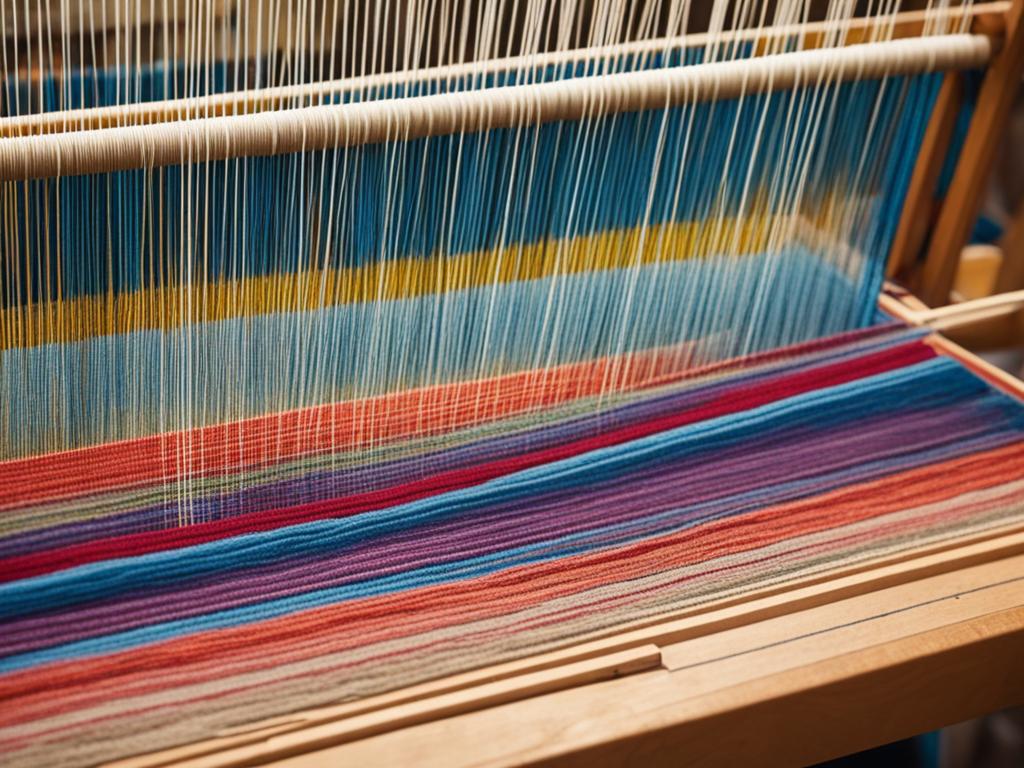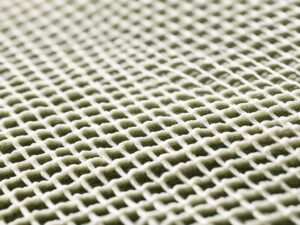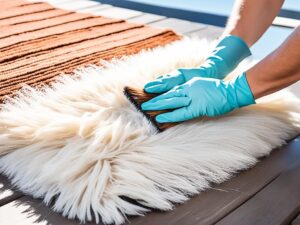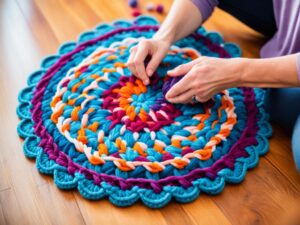Rug making is a fascinating process that encompasses craftsmanship, diverse materials, and intricate weaving techniques. From the traditional artistry of handmade rugs to the efficiency of modern machine-made ones, the world of rug construction offers a rich tapestry of creativity and cultural significance. In this article, we will delve into the detailed process of how rugs are made, exploring the materials used, weaving techniques employed, and the cultural heritage woven into each thread.
Key Takeaways:
- Rugs are made using a variety of materials, including wool and cotton, with natural dyes used for vibrant colors.
- The traditional rug making process involves shearing, spinning, dyeing, and weaving on handlooms.
- Modern rug production utilizes machines and synthetic materials for mass production.
- Rug making holds cultural significance, reflecting artistry, craftsmanship, and storytelling traditions.
- Global influences have shaped rug making, bringing new designs and techniques from various regions.
Materials Used in Rug Making
When it comes to rug making, the choice of materials plays a crucial role in determining the quality, durability, and overall aesthetic appeal of the finished product. Let’s take a closer look at the primary materials used in rug making:
1. Wool
Wool is the most common and valued material used in rug making. It offers exceptional durability, inherent softness, and natural resistance to stains and wear. Wool rugs have a luxurious feel underfoot and can withstand heavy foot traffic without losing their shape or color. The use of wool in rug making can be traced back centuries and remains a popular choice due to its unique properties.
2. Cotton
In addition to wool, cotton is also frequently used in rug making. Cotton is primarily used for the warp threads of the rug, which provide structural stability. Compared to wool, cotton is lighter and less expensive, making it an economical choice for certain rug types. Cotton warp threads also allow for tighter and more intricate designs to be woven into the rug.
3. Natural Dyes
Rugs derive their vibrant colors from natural dyes obtained from various sources such as plants, minerals, and even insects. These natural dyes add an organic touch to the rugs and are known for producing beautiful, rich hues that age gracefully over time. Unlike synthetic dyes, natural dyes are eco-friendly and contribute to the overall appeal of handmade rugs.
“The use of high-quality materials, such as wool and natural dyes, ensure that rugs not only look visually stunning but also stand the test of time.” – Rug Expert
By using these materials, rug artisans create masterpieces that showcase their skills, craftsmanship, and the rich cultural heritage of the regions they come from.
Now, let’s delve into the traditional rug making process in Section 3, where we will explore the intricate steps involved in creating a handcrafted rug.
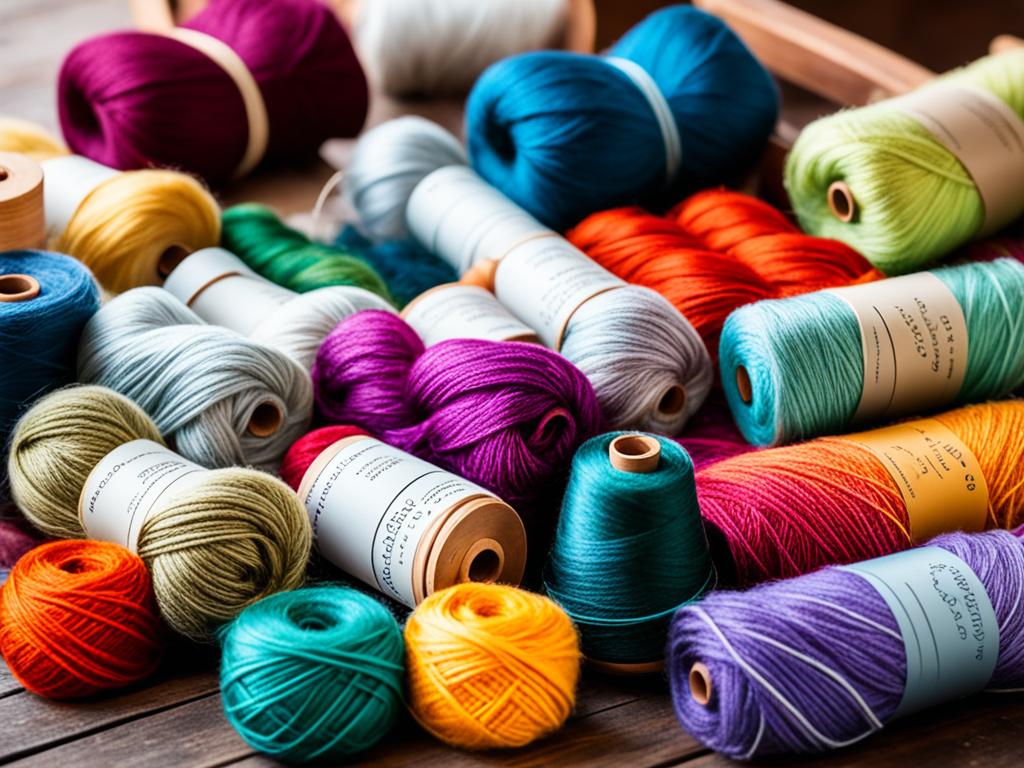
| Material | Properties |
|---|---|
| Wool | Durable, soft, natural resistance to stains and wear |
| Cotton | Structural stability, lighter, and economical |
| Natural Dyes | Rich, vibrant colors, eco-friendly |
Traditional Rug Making Process
Traditional rug making is a meticulous process that involves several intricate steps, showcasing the artistry and craftsmanship of skilled artisans. Let’s delve into the fascinating journey of creating a traditional rug, from sheep shearing to finishing touches.
Shearing: Collecting the Wool
The process begins with shearing the sheep to collect their wool, which serves as the primary material for the rug. Skilled shearers carefully remove the fleece to ensure the highest quality of wool for the rug making process.
Spinning: Turning Wool into Yarn
After shearing, the wool goes through a thorough cleaning process to remove impurities. Once cleaned, the wool is spun into yarn using traditional methods, such as using a spinning wheel or drop spindle. The spinning process creates strong and durable yarn, ready to be woven into a beautiful rug.
Dyeing: Infusing Colors
The yarn is then dyed using natural dyes derived from plants, minerals, and insects. Artisans skillfully apply the dyes, imparting vibrant hues to the yarn. This step allows for the creation of intricate designs and patterns, adding depth and character to the rug.
Weaving: Bringing Patterns to Life
Using a handloom, artisans carefully weave the dyed yarn onto the warp threads, following specific weaving techniques. This meticulous process brings the intricate patterns and designs to life, showcasing the artistry and creativity of the weaver. Each knot and stitch is crafted with precision and care, reflecting the rich cultural heritage and traditions.
Finishing: The Final Touches
Once the weaving is complete, the rug undergoes a series of finishing processes. It is washed to remove any remaining impurities and then trimmed and bound to achieve clean edges. These finishing touches ensure that the rug is of the highest quality, ready to adorn any space with its timeless beauty.
Traditional rug making is a labor of love, where every step is infused with skill, heritage, and dedication. It is a celebration of artistry and craftsmanship that produces exquisite rugs cherished for generations.
Modern Rug Production Techniques
In today’s world, modern rug production techniques have revolutionized the way rugs are made. Machine-made rugs have become increasingly popular due to their efficiency, affordability, and ability to replicate intricate designs quickly.
One of the key factors in modern rug production is the use of synthetic materials such as nylon and polyester. These materials offer enhanced durability and are more resistant to stains and wear compared to natural fibers like wool or cotton.
Machine-made rugs are created using automated processes, allowing for mass production. Advanced machinery can produce a large number of rugs in a relatively short amount of time, meeting the high demand in the market.
While machine-made rugs may lack the artistry and uniqueness of handmade rugs, they provide a cost-effective option for consumers who want a stylish and affordable rug for their homes.
The Benefits of Machine-Made Rugs
Machine-made rugs have several advantages over handmade rugs:
- Affordability: Machine-made rugs are generally more budget-friendly compared to handmade rugs, making them accessible to a wider range of consumers.
- Variety of Designs: With modern technology, machine-made rugs can replicate intricate patterns and designs, providing a wide range of options to choose from.
- Durability: Synthetic materials used in machine-made rugs are known for their durability, making them suitable for high-traffic areas in homes and commercial spaces.
- Consistency: Machine-made rugs offer consistent quality and uniformity in terms of size, shape, and design, ensuring a cohesive look in any room.
Machine-made rugs are a testament to modern rug production techniques, combining efficiency, affordability, and quality. While they may not have the same level of craftsmanship as handmade rugs, they offer a practical and stylish solution for those seeking a beautiful rug without breaking the bank.
To understand the impact of modern rug production techniques, it’s important to consider the cultural and historical significance of rugs globally. The next section will delve into the cultural significance of rug making and its contribution to artistry and craftsmanship.
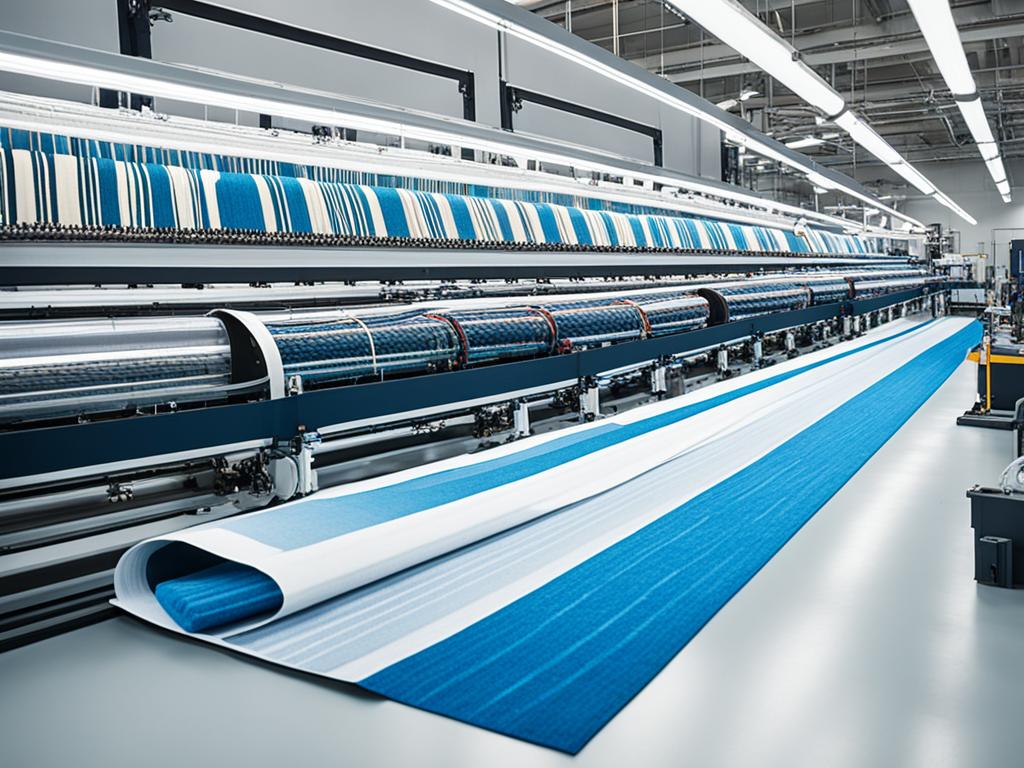
Cultural Significance of Rug Making
Rug making holds immense cultural significance in numerous societies worldwide. It is revered as a form of artistry and craftsmanship that beautifully reflects the cultural heritage of a community. In countries like Morocco, rugs are not merely functional floor coverings; they also serve as a tangible link to the country’s rich history and cherished traditions. Each rug is an exceptional expression of the weaver’s creativity and individuality, encapsulating the essence of their cultural identity.
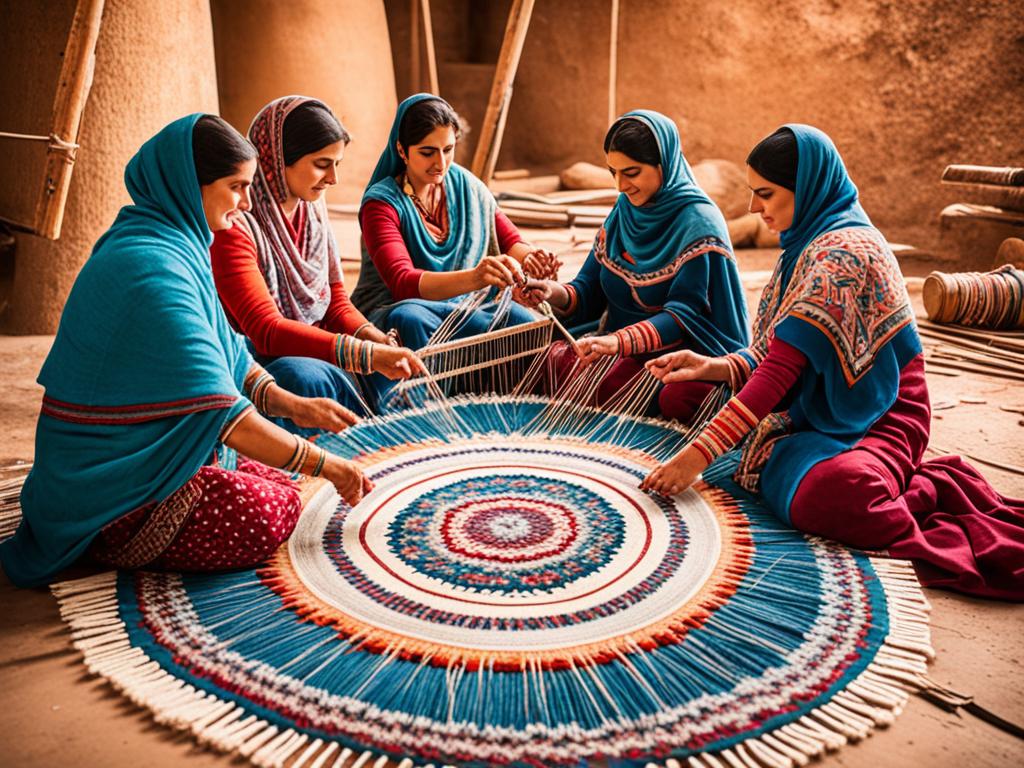
Rug making is steeped in cultural heritage, with patterns, motifs, and techniques passed down through generations. The intricate designs and meticulous craftsmanship embody the stories, beliefs, and values of a society, making rugs more than just household items. They serve as tangible artifacts that preserve and celebrate cultural heritage, ensuring tradition and artistic expression endure for future generations to appreciate.
Global Influences on Rug Making
The art of rug making has been shaped by global interactions throughout history. Conquests, trade routes, and cultural exchanges have played significant roles in influencing rug designs and patterns across different regions.
One of the most notable global influences on rug making is the introduction of Oriental carpets and Persian rugs. These exquisite carpets have captivated people’s imagination for centuries with their intricate designs and unparalleled craftsmanship.
Oriental carpets originated from various regions including Persia (now Iran), Turkey, China, and India. They became highly sought after as luxury items, prized for their beauty, durability, and artistry. When trade routes opened between East and West, Oriental carpets became coveted treasures, symbolizing wealth and status. Their arrival in Europe sparked a fascination with Eastern aesthetics and inspired European weavers to attempt to recreate their exceptional craftsmanship.
Persian rugs, renowned for their exquisite patterns and fine knots, have long been regarded as the pinnacle of rug artistry. The intricate motifs and designs featured in Persian rugs often reflect the cultural heritage and historical events of the region. The art of Persian rug making has been passed down through generations, with master weavers dedicating their lives to perfecting their craft.
The influence of Oriental carpets and Persian rugs expanded across continents over time, carried by conquerors, explorers, and merchants. The global demand for these rugs facilitated the spread of rug weaving techniques, designs, and motifs. As artists and weavers encountered new cultures, they incorporated these influences into their work, resulting in a fusion of styles and artistic expression.
“The intricate designs and craftsmanship of Oriental carpets and Persian rugs have left an indelible mark on rug making, showcasing the richness of cultural exchanges.”
This intermingling of cultures and design influences contributed to the globalization of rug artistry, creating a diverse range of rug styles that reflect the international tapestry of influences. From the geometric patterns of tribal rugs to the floral motifs of Turkish Kilims, each rug tells a story of cultural cross-pollination and the evolving nature of artistic expression.
| Global Influences on Rug Making | Cultural Origins |
|---|---|
| Oriental Carpets | Eastern regions including Persia, Turkey, China, and India |
| Persian Rugs | Originated in Persia (now Iran) |
| Tribal Rugs | Native communities across different continents |
| Turkish Kilims | Turkey and surrounding regions |
| Moroccan Rugs | Morocco and North Africa |
These cultural exchanges continue to shape the world of rug making, providing endless possibilities for creativity and innovation. Today, rug artisans draw inspiration from global influences to create unique and contemporary designs that pay homage to tradition while embracing modern aesthetics.
Conclusion
The process of making rugs is a labor-intensive and highly skilled endeavor that combines artistry, craftsmanship, and cultural traditions. The enduring beauty of these handmade textiles is a testament to the dedication and skill of the artisans who bring them to life.
Rugs are not just functional floor coverings; they are works of art that reflect the cultural heritage and creativity of their makers. Each rug tells a story, weaving together threads of history, tradition, and personal expression.
From the intricate designs of Oriental carpets to the time-honored techniques of Persian rugs, the art of rug making is a window into the rich tapestry of global cultures. It is a celebration of human ingenuity, transforming humble materials into objects of lasting beauty that transcend time and place.
